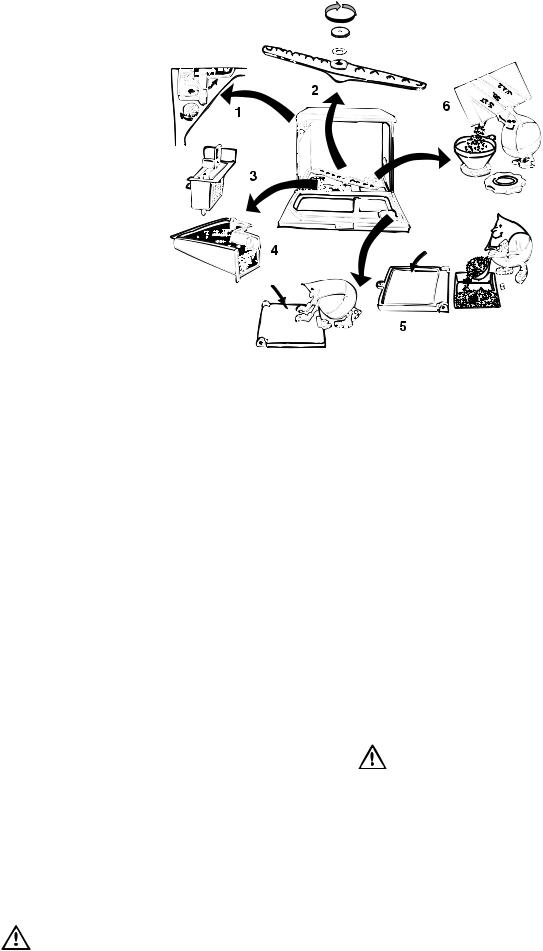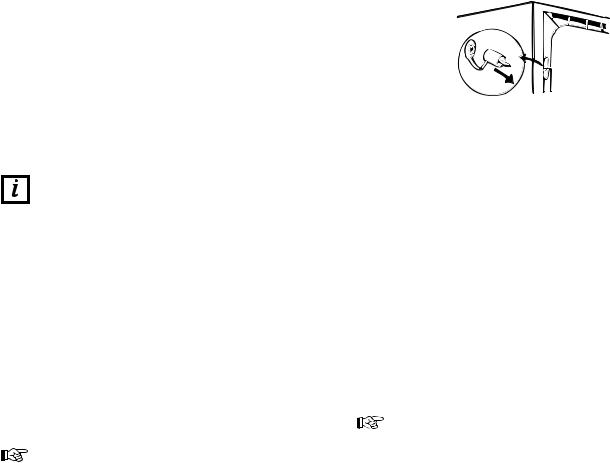Zanussi DCS 14 W, DCS 14 S User Manual

D I S H WA S H E R
D C S 1 4 W
D C S 1 4 S
822 90 11-22 |
I N S T R U C T I O N B O O K L E T |

Contents
For the user
Important safety information
Care and cleaning
-General cleaning
-Rinse aid dispenser
-Spray arm
-Coarse filter
-Fine filter
-Detergent dispenser
-Water softener
-Water softener plug
-Cleaning the cabinet
For the installer
3 |
Technical specifications |
12 |
4-5 |
Unpacking the machine |
13 |
-If the machine is damaged
-Use
-Protecting the machine against freezing
Installation |
14-15 |
-Water inlet
-Water drainage
-Power supply
The control panel and programmes 6
How to load the dishwasher |
7 |
-Instruction for test centres |
|
Using your appliance |
8 |
In the event of a fault |
9 |
Service |
10 |
- Service and Spare Parts |
|
- Customer Care Department |
|
Guarantee Conditions |
11 |
Guide to use the instruction book
The following symbols will be found in the text to guide you throughout the instructions:
 Safety instructions
Safety instructions
 Step by step instructions
Step by step instructions
 Hints and tips
Hints and tips
Environmental information
- 2 -

Important safety information
Before installing and first using the dishwasher, read the instruction booklet carefully, including its hints and warnings. Doing so will ensure that your machine will perform properly and to best advantage. Anyone using the machine should be thoroughly familiar with its instructions for use and safety features. Save these instructions and make sure they remain with the machine if it is moved or sold, so that everyone using it through its life can be properly informed on appliance use and safety.
Installation and servicing
■All installation and service work done on the product must be carried out by a qualified technician. Work performed by persons with inadequate knowledge may adversely affect the satisfactory functioning of the product and may cause personal injury or damage. Before any work is carried out on the dishwasher, it must be isolated from the electrical supply. To do this the power plug must be removed from the wall socket.
■Water connection shall be made via an easily accessible stopcock.
■The power cable must be plugged into an earthed socket, which must to be easily accessible. Permanent installation must only be carried out by an authorized electrician.
■Make sure that the power cord is not nipped or otherwise damaged and that its hoses do not get crushed or kinked when moving the dishwasher in connection with installation or cleaning etc.
■Servicing and possible repairs must be carried out by a service company authorized by the supplier. Use only spare parts supplied by these. Never try to repair the dishwasher yourself.
Child Safety
■The dishwasher should be used by adults only. Do not let children play with the controls or other parts of it.
■Keep all packaging well away for children.
■Keep all detergents in safe place out of children´s reach.
■Prevent children from sitting, swinging or standing on the open door.
■If you take any dishes out of the machine before the end of the dishwashing cycle, it is extremely important to rinse them thoroughly under running water to remove any remaining detergent.
■Do not place sharp knives with their points upwards. It is much safer to lay them horizontally in the basket.
■When finishing loading or unloading close the door, as an open door can be a hazard.
■Make sure that the machine is disconnected from the power supply during cleaning and maintenance work.
■After using the machine, turn off its water supply and disconnect it from the power supply. When removing the electrical plug, grip the plug, not the lead.
Identification of materials
All materials used in packaging this machine are environmentally-friendly. The various plastics used are identified and can be recycled:
•PE stands for polyethylene, which is used for the bag around the machine and the bag in which these instructions were supplied.
•PS stands for polystyrene (moulded), which is used for the sections of packaging needed to cushion the machine.
The cardboard components of the packaging are made from recyclable paper and should be taken to a collection point for recycling.
The machine contains plastic and rubber components. These have identifying marks to show what they are made from, so they can be recycled or disposed of properly at the end of the machine's life.
The materials are identified according to international standards.
During Use
■This dishwasher is designed solely for washing household utensils suitable for machine washing. Using it for other purposes could lead to physical injury or damage to property and invalidate the guarantee.
■Avoid opening the door while the dishwasher is running, as hot steam may escape.
■Only use detergent specifically designed for use in dishwashers.
- 3 - |
822 90 11-22 |

Care and cleaning
Important
Make sure that the machine is unplugged and the water turned off before undertaking any kind of maintenance.
General cleaning
Inspect the filters and spray arm nozzle before re-loading the machine and remove any food scraps. Wipe round the rubber gasket at the bottom of the door to remove grease which tends to collect there.
Rinse aid dispenser (1)
Use of rinse aid will result in faster drying of the load and gives the dishes a shiny finish. It may be necessary to adjust the quantity of rinse aid dispensed if you live in either a very hard water or a very soft water area. More is needed for hard water and less for soft water. Leave the dispenser in its preset position when you first use the dishwasher and only adjust if, after a few cycles, you notice the following:
•Crockery remaining dull looking and/or showing occasional round spots. If this happens, increase the quantity of rinse aid by turning the red dial below the filter trough clockwise.
•Crockery feeling sticky or showing whitish spots. If this happens, decrease the quantity of rinse aid by turning the red dial below the filler trough anti-clockwise.
The dispenser holds about 140 ml. This is enough for 4070 wash cycles, depending on the dosage setting. When the rinse aid level is approaching the bottom of the scale it is time to refill the dispenser. Swivel out the filler trough and carefully fill up with rinse aid until the level reaches up to the red mark on the level indicator tube. Do not overfill, and carefully wipe off any spillage with a damp cloth immediately. Don’t forget to close the filler trough afterwards.
Do not fill the rinse aid dispenser with liquid detergent.
Spray arm (2)
The holes in the spray arm nozzle must be kept free of scraps for the efficiency of the washing action. Inspect the spray arm regularly. When thorough cleaning is necessary, remove the spray arm by unscrewing the nut clockwise (it has a left-handed thread) and lift off the spray arm.
Wash the spray arm with hot soapy water using a stiff saucepan brush if necessary to remove scraps.
Re-assemble carefully, making sure the nut is secure.
Coarse filter (3)
The purpose of the coarse filter is to catch large objects such as toothpicks and pieces of eggshell. Make sure that the filter is always clean. Lift it out and rinse it under running water whenever necessary.
Fine filter (4)
It is just as important to keep this filter clean. A dirty or clogged filter will impair washing efficiency. The fine filter can easily be lifted out for cleaning when you have removed the coarse filter.
The dishwasher must not be used without the filters. Incorrect repositioning of the filters will produce poor washing results.
Cleaning of the filters is vital to ensure correct operation of the machine.
- 4 -

Detergent dispenser (5)
Only use detergents specially designed for dishwashers. Open the detergent compartment on the inside of the door
by pushing the lid catch sideways. Pour the detergent into 7 the compartment, for a normal load pour about 15g.
Close the lid firmly. The detergent will be automatically dispensed at the right time. Pre-wash detergent is not generally needed, but if the dishes are heavily soiled add an extra 5g anywhere on the inside of the door.
Since not all detergents are the same, you should also consult the instructions on the packet. Using the correct amount of detergent also contributes to reducing pollution.
Zanussi recommends the use of Finish dishwasher detergent and Rinse Aid.
Water softener (6)
This dishwasher is equipped with a water softener for hard (chalky) water, therefore the rinse aid dispenser should be set for a low dosage.
The lime (chalk) in hard water causes white deposits to occur on dishes and the interior of the dishwasher.
To prevent this, the water has to pass through a special container where its hardness is removed. Since the water softener consumes coarse dishwasher salt, you will have to replenish the salt container after a certain number of dishwashing cycles. When the indicator lamp on the control panel lights up, it is time to fill up with salt.
Proceed as follows:
1. Unscrew the salt container filler cap.
2.Fill up salt container with water (only the first time).
3.Fill the container with coarse salt. Use the funnel supplied with the machine.
Ordinary domestic salt will affect the efficiency of the water softener and damage it.
4.Remove the funnel and wipe off any spillage.
5.Screw the filler cap back in place.
The salt container holds about 1 litre, which is enough for about 20 - 30 dishwashing cycles. Always ensure that there is water in the salt container before filling salt.
Water softener plug (7)
As supplied from the factory, the water softener is set for a water hardness of up to 20°dH. If your water is harder than this, you can increase the capacity of the water softener by pulling out the rubber plug at the rear of the dishwasher on the left hand side viewed from the back. See illustration.
Contact your local Water Authority to find the exact water hardness level for your area.
Never run the dishwasher without salt in the container as this may damage the water softener. If the damage is slight, the water softener function can be partially restored by filling the container with salt and then running the Normal cycle 4-5 times.
Cleaning the cabinet
Wipe the outside of the cabinet and control panel regularly with a soft damp cloth. When necessary, use liquid kitchen or household cleaner to remove stubborn marks, rinse with a damp cloth and rub up with a soft duster.
Never use abrasive cleaners which could damage the surface, ie: scouring pads or solvents (acetone, trichloriethylene, etc).
If the machine is not going to be used for some time, take the folllowing precautions:
1. Unplug the machine and turn off the water supply.
2.Fill up the rinse aid container.
3.Make sure the tub is clean by carrying out a wash programme (without any crockery) using Finish Dishwasher cleaner, then dry the inside thoroughly.
4.Leave the door ajar.
- 5 -
